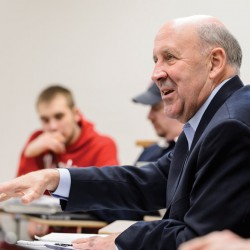Our Brains Made Us Do It
A unique program explores how science plays out in society.

Students in the UW’s Neuroscience and Public Policy program study economics and government in addition to doing research. Pnoto: Bryce Richter
Melding of mind and policy matters is all in a day’s work for the graduate students in the UW–Madison Neuroscience and Public Policy program.
Since 2005, the program has offered students the chance to explore the intersection of science and society while earning graduate degrees in both neuroscience and public affairs. The goal? Training a cadre of scientists well versed in the realms of both scientific research and policy.
As the study of the brain and nervous system, neuroscience holds a unique position for policy implications, says Ronald Kalil, program director and neuroscience professor. “Our brain defines who we are. In so many areas impacting human life, policy and law are predicated upon notions of how we function behaviorally as humans — notions that may be in need of revision,” he says, citing as examples childhood education, prosecution of juvenile criminals, health care, and the concept of personal responsibility underpinning the legal system.
The program — the only one of its kind in the country — is a partnership between the Neuroscience Training Program in the Graduate School and the La Follette School of Public Affairs. It couples a PhD in neuroscience with a master’s degree in either public affairs or international public affairs. Students undertake a heavy course load in neurobiology, policy analysis, economics, and government to work toward the two degrees simultaneously. They also gain hands-on policy experience through a summer internship at a foundation, government agency, or other institution.
“[Policy is] very different from science and academia, and translation between the two is often not understood very well,” says Patric Hernandez MPA’10, PhDx12, who worked last summer in the Government Accountability Office on the transparency of government stimulus spending.
He and Lindsay Pascal MPA’10, PhDx12 are the first students to complete the master’s portion of the program and are now continuing their dissertation research in neuro-science — Hernandez on functional brain imaging and Pascal on the brain’s role in regulating eating behavior. Both students plan to pursue careers that will draw upon their policy experiences, possibly in science administration, management, research policy development, or curriculum design.
“This was the only program I found anywhere in the country that allowed me to explore my policy interests without sacrificing a basic research track,” says Pascal. “It’s definitely made me think more about what my work means [and its] place in the world instead of just what it means in my little scientific niche.”
Published in the Summer 2011 issue



Comments
Jay July 17, 2011
I hope this research is not as simplistic as it sounds. Placing scientific findings completely outside of social, cultural, and historical contexts is extremely dangerous. That’s even more true when we aim to use that science to make changes in the law.
Perhaps the neuroscientists should be paired up with historians rather than with policy analysts, or that pairing should at least come first. I find it hard to believe that concepts like childhood and adolescence can be completely brain-driven given that they are recent historical developments. Did our brains change in the late 1930s, which is when the teenager as we know it came into being?
I don’t doubt that neuroscientists find differences between “adult” and “teenage” brains. But they might want to investigate when those differences developed and how related or unrelated to culture those differences are, given that “teenagers” don’t exist all over the world and have not existed until relatively recently in human history.
The thought of policy decisions being made on this “science” alone is deeply disturbing.